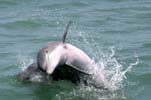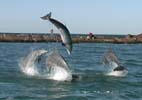 |
The
Valley is rich in the diversity of its mammals, including
the smaller inshore dolphins of South Padre Island. They
live in the rich waters of the Laguna Madre Bay and the
inshore waters of the Gulf of Mexico, along the beach
of South Padre. They breathe air and nurse their young.
Not a fish but a kindred spirit of the water, they are
the Bottlenose Dolphins of the Rio Grande Valley, Tursiops
Truncatus. These dolphins have adapted to the shallow
|
waters of the Laguna Madre and are therefore
smaller than their offshore cousins which can reach lengths
of 12 feet. Inshore dolphins grow only seven to nine feet in
length, making it easier for them to get around in the shallows.
Their weight is considerably less as well, averaging about 400
pounds, in comparison to their offshore compatriots, which can
weigh as much as 600 pounds.
There are five major family groups of about 25 members apiece
of these inshore dolphins, each led by a wise matriarch. The
matriarch plays an important role in leading the group, using
the experience and knowledge passed on to her by a previous
matriarch. The matriarch dictates what the group will do at
different times of the day, whether it be feeding, sleeping
or playing.
Protected by the Federal Government these wild dolphins lead
their lives safely in the bay and gulf waters. They are “fishatarians”
eating a variety of fish such as mullet, sheepshead, ribbonfish
and many others. They consume up to 10 percent of their body
weight in fish per day. Dolphins
are big-brained animals, as are we, and can learn to adapt to
changes in their environment. They populated Valley coastal
waters long before the arrival of humans and must have led a
much quieter life with no sounds of human activity on their
waters. But they have learned quickly with each successive generation
to adapt to the new creatures in their world and also to the
new threats they bring with them (such as wave runners). Now
their daily activities even include playing with these two-legged
interlopers. After all, they share
something very special with their human counterparts…emotions.
They react to people reacting to them. And they have had years
to get to know the people on their waters.
A unique feature of inshore dolphins is their more highly developed
ability to use echo location when compared to most offshore
dolphins. Bay waters are often murky and inshore dolphins cannot
use their eyes to see as the offshore dolphins are able to do
in the clear blue water of their environment. Echo location
serves as sonar that allows the inshore dolphins to see much
as we see on a sonogram. Quite often they will feed in the murky
water in preference to the clear water nearby because, while
the fish cannot see them, they can “see” the fish
using their echo location.
 |
These amazing creatures
live up to 40 years in the wild. Since they have only
one set of teeth during their lifetime, their age can
be determined by counting the rings on a half section
of one of their teeth, similar to counting the rings of
a tree stump. They have a great memory base as humans
do and have learned to recognize different boats and even
the people that spend time with them. We can easily recognize
individual dolphins by the dorsal fin on their |
backs. They can range in color from white
to black. The mothers and babies stay together while the young
males of four years old and up band together and are taught
how to behave together by the older male bulls. The matriarchs
share their wisdom with matriarchs in training so that knowledge
can be passed down from generation to generation.
Mothers keep their babies at their sides for three to four years
before they have another baby. The gestation period is 11 months,
and, if the first baby is a female, she will help her mother
raise the next baby, learning to become a mother herself someday.
If the baby is a male he will go on to the male group. A mother
and baby can often be seen alone together, spending a little
quality time away from the main group, but later they join re-join
the other family members.
The babies have much to be taught as they grow, not unlike the
time spent raising a human baby. One dolphin year counts as
two human years, making an eight-year-old dolphin similar in
age to a sixteen-year-old human. Dolphins will have as many
as five or six children in their lifetime. The females raise
the children while the males lead separate lives in their own
groups as they reach maturity which is about seven or eight,
but they will still intermingle with their family groups, visiting
mothers and siblings. Nacho, a white female, brought her baby
up to the boat the day he was born. Nacho’s son Titan
is now six years old, and even though he is officially in the
male group led by Frosty, he still spends time with his mother
now and then. He has been filmed and documented since the day
he was born. It is illegal to
feed, touch or swim with dolphins in the wild, but interacting
with humans by sharing emotions is both legal and welcome. They
react to human emotions of joy and, if they are not sleeping,
eating or on a mission at the time, they will share emotions
through play. They don’t have to bring their eyes out
of the water to breathe, so when they do they are looking at
their onlookers. They recognize people and enjoy seeing reactions
to their play. They will tussle around, much like schoolboys
on a playground. They even play
with things in the water such the Cabbage Head Jelly fish and
Sargasso Seaweed or even their food. Throwing fish around is
not an uncommon sight.
Mothers will give their babies permission to play when they
are old enough, too. It is a joy indeed to see the babies playing
together under the watchful eyes of their mothers.
The joy that Dolphins bring to humans is very special, and there
is no question that the bond between humans and dolphins is
on the emotional level. Here is a species of mammal that shares
the same emotions with their family and friends as humans do
with theirs.
| Much
as the human families of the Valley go about their daily
business, so do the dolphins of the Laguna Madre Bay.
They spend their whole lives here and matriarchs such
as Can Opener, Dottie and Jasmine, have enjoyed long and
prosperous lives leading their families. Frosty, the male
bull, leads the younger males, Sharkey, Nicky, Titan and
many others by sharing the knowledge |
 |
gained during his long life. Having been
out on the water with these dolphins for eight years filming
and documenting them has been a wonderful experience, and they
have become very much a part of our family. There are five major
family groups that we recognize and have come to know well.
One thing is certain; they are a part of the Valley’s
nature ecosystem of which we can all be proud. Scarlet
and George Colley of South Padre Island's "Fins
to Feathers" have been filming and documenting
their dolphins for eight years. They operate a tour business
on the Island and write seven articles a month for local papers
on the nature of the Island.
|